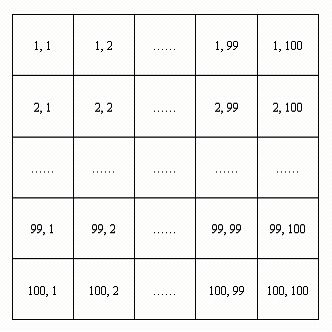poj-1656-Counting Black-(树状数组)
2017-08-25 21:12
309 查看
There is a board with 100 * 100 grids as shown below. The left-top gird is denoted as (1, 1) and the right-bottom grid is (100, 100).

We may apply three commands to the board:
In the beginning, all the grids on the board are white. We apply a series of commands to the board. Your task is to write a program to give the numbers of black grids within a required region when a TEST command is applied.
Input
The first line of the input is an integer t (1 <=
4000
t <= 100), representing the number of commands. In each of the following lines, there is a command. Assume all the commands are legal which means that they won't try to paint/test the grids outside the board.
Output
For each TEST command, print a line with the number of black grids in the required region.
Sample Input
5
BLACK 1 1 2
BLACK 2 2 2
TEST 1 1 3
WHITE 2 1 1
TEST 1 1 3
Sample Output
7
6
题目给出n组数据,每组形式为x1,y1,l,每组数据形成一个矩阵(x1,y1)为左上角,(x1+l-1,y1+l-1)为右上角,给出3种操作,1.把矩阵内方块全部变白,2.全部变黑,3.统计黑块个数,
题目可以用树状数组做,但是看到这么小的数据,还是暴力解更合适,运行时间也说明了一切
代码(树状数组)(625 MS ,4708 KB):
代码(0 MS ,748 KB):

We may apply three commands to the board:
1. WHITE x, y, L // Paint a white square on the board, // the square is defined by left-top grid (x, y) // and right-bottom grid (x+L-1, y+L-1) 2. BLACK x, y, L // Paint a black square on the board, // the square is defined by left-top grid (x, y) // and right-bottom grid (x+L-1, y+L-1) 3. TEST x, y, L // Ask for the number of black grids // in the square (x, y)- (x+L-1, y+L-1)
In the beginning, all the grids on the board are white. We apply a series of commands to the board. Your task is to write a program to give the numbers of black grids within a required region when a TEST command is applied.
Input
The first line of the input is an integer t (1 <=
4000
t <= 100), representing the number of commands. In each of the following lines, there is a command. Assume all the commands are legal which means that they won't try to paint/test the grids outside the board.
Output
For each TEST command, print a line with the number of black grids in the required region.
Sample Input
5
BLACK 1 1 2
BLACK 2 2 2
TEST 1 1 3
WHITE 2 1 1
TEST 1 1 3
Sample Output
7
6
题目给出n组数据,每组形式为x1,y1,l,每组数据形成一个矩阵(x1,y1)为左上角,(x1+l-1,y1+l-1)为右上角,给出3种操作,1.把矩阵内方块全部变白,2.全部变黑,3.统计黑块个数,
题目可以用树状数组做,但是看到这么小的数据,还是暴力解更合适,运行时间也说明了一切
代码(树状数组)(625 MS ,4708 KB):
#include<iostream>
#include<string>
#include<cstdio>
#include<algorithm>
#include<cmath>
#include<iomanip>
#include<queue>
#include<cstring>
#include<map>
#include<vector>
using namespace std;
typedef long long ll;
#define M 105
int tree[M][M],vis[M][M];
inline int lowbit(int i)
{
return i&(-i);
}
void add(int x,int y,int v)
{
int i,j;
for(i=x;i<M;i+=lowbit(i))
for(j=y;j<M;j+=lowbit(j))
{
tree[i][j]+=v;
}
}
int sum(int x,int y)
{
int i,j,res=0;
for(i=x;i>0;i-=lowbit(i))
for(j=y;j>0;j-=lowbit(j))
{
res+=tree[i][j];
}
return res;
}
int main()
{
int T,x1,y1,x2,y2,l,i,j;
char str[10];
scanf("%d",&T);
while(T--)
{
getchar();
scanf("%s",str);
scanf("%d%d%d",&x1,&y1,&l);
x2=x1+l-1;
y2=y1+l-1;
if(str[0]=='B')
{
for(i=x1;i<=x2;i++)
for(j=y1;j<=y2;j++)
{
if(vis[i][j]==0) {add(i,j,1);vis[i][j]=1;}
}
}
else if(str[0]=='W')
{
for(i=x1;i<=x2;i++)
for(j=y1;j<=y2;j++)
{
if(vis[i][j]==1) {add(i,j,-1); vis[i][j]=0;}
}
}
else
{
printf("%d\n",sum(x2,y2)+sum(x1-1,y1-1)-sum(x2,y1-1)-sum(x1-1,y2));
}
}
return 0;
}代码(0 MS ,748 KB):
#include<iostream>
#include<string>
#include<cstdio>
#include<algorithm>
#include<cmath>
#include<iomanip>
#include<queue>
#include<cstring>
#include<map>
#include<vector>
using namespace std;
typedef long long ll;
#define M 105
int tree[M][M];
int main()
{
int n,i,j,x1,y1,l,x2,y2;
char str[10];
scanf("%d",&n);
while(n--)
{
getchar();
scanf("%s",str);
scanf("%d%d%d",&x1,&y1,&l);
x2=x1+l-1;
y2=y1+l-1;
if(str[0]=='B')
{
for(i=x1;i<=x2;i++)
for(j=y1;j<=y2;j++)
{
tree[i][j]=1;
}
}
else if(str[0]=='W')
{
for(i=x1;i<=x2;i++)
for(j=y1;j<=y2;j++)
{
tree[i][j]=0;
}
}
else
{
int num=0;
for(i=x1;i<=x2;i++)
for(j=y1;j<=y2;j++)
{
if(tree[i][j]==1) num++;
}
printf("%d\n",num);
}
}
return 0;
}
相关文章推荐
- poj 1656(二维树状数组解法)
- POJ 1656 二维树状数组简单应用
- poj 1656(二维树状数组解法)
- POJ 2299 Ultra-QuickSort【树状数组 ,逆序数】
- POJ 2352 Stars(树状数组)
- HDU 1541 & POJ 2352 Stars (树状数组)
- POJ 3468 A Simple Problem with Integers(树状数组区间修改+区间查询)
- POJ 题目2182 Lost Cows(树状数组+二分)
- [树状数组] poj 1990 MooFest
- POJ 3067 Japan (树状数组 + 逆序数)
- POJ 3067 Japan(树状数组求逆序对)
- poj 2352 Stars (树状数组)
- POJ 1990 MooFest(树状数组)
- poj 2352 树状数组
- poj-2352 && HDU-1541 --Stars(树状数组)
- POJ 2481 Cows (树状数组)
- POJ 3468 的树状数组解法
- POJ 1990 MooFest(想法题&树状数组)
- poj 2155 Matrix 二维树状数组
- 【POJ】2352 - Stars(树状数组)
